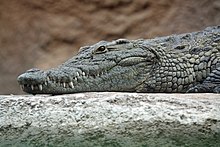Diapsida
| Diapsid reptiles Temporal range: Pennsylvanian–Present, 307–0 Ma |
|
|---|---|
 |
|
| Life restoration of an araeoscelidian (Petrolacosaurus kansensis) | |
 |
|
| Nile crocodile (Crocodylus niloticus) | |
| Scientific classification | |
| Kingdom: | Animalia |
| Phylum: | Chordata |
| Class: | Reptilia |
| Clade: | Romeriida |
| Clade: |
Diapsida Osborn, 1903 |
| Subgroups | |
|
|
Diapsids ("two arches") are a group of amniote tetrapods that developed two holes (temporal fenestra) in each side of their skulls about 300 million years ago during the late Carboniferous period. The diapsids are extremely diverse, and include all crocodiles, lizards, snakes, tuatara, turtles, and dinosaurs (both avian and non-avian). Although some diapsids have lost either one hole (lizards), or both holes (snakes and turtles), or have a heavily restructured skull (modern birds), they are still classified as diapsids based on their ancestry. At least 7,925 species of diapsid reptiles exist in environments around the world today (nearly 18,000 when birds are included).
The name Diapsida means "two arches", and diapsids are traditionally classified based on their two ancestral skull openings (temporal fenestrae) posteriorly above and below the eye. This arrangement allows for the attachment of larger, stronger jaw muscles, and enables the jaw to open more widely. A more obscure ancestral characteristic is a relatively long lower arm bone (the radius) compared to the upper arm bone (humerus).
Diapsids were originally classified as one of four subclasses of the class Reptilia, all of which were based on the number and arrangement of openings in the skull. The other three subclasses were Synapsida (one opening low on the skull, for the "mammal-like reptiles"), Anapsida (no skull opening, including turtles and their relatives), and Euryapsida (one opening high on the skull, including many prehistoric marine reptiles). With the advent of phylogenetic nomenclature, this system of classification was heavily modified. Today, the synapsids are often not considered true reptiles, while Euryapsida were found to be an unnatural assemblage of diapsids that had lost one of their skull openings. Genetic studies have shown that this is also the case in turtles, which are actually heavily modified diapsids. In phylogenetic systems, birds (descendants of traditional diapsid reptiles) are also considered to be members of this group.
...
Wikipedia
